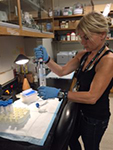Diemut Strebe, Ida Ely Rubin Artist in Residence at the MIT Center for Art, Science & Technology, and Brian L. Wardle, Professor of Aeronautics and Astronautics and the director of the necstlab and Nano-Engineered Composite Aerospace Structures Consortium, are applying new research in engineered materials and structures to artworks. The necstlab research group’s mission is to lead the advancement and application of new knowledge at the forefront of materials and structures understanding, with contributions in both science and engineering.
The Redemption of Vanity is a 16-carat color diamond covered with a grown “forest” of carbon nanotubes (CNTs). The CNTs absorb 99.965 percent of light, creating the blackest black material on earth. Although the diamond and CNTs are the same element—carbon—the different atom lattice structure creates opposing extremes in appearance upon exposure to light, despite being comprised of the same object.
For Strebe and Wardle, the literal devaluation from a $2 million stone to a tiny black hole challenges the art market and explores how material and immaterial value is attached to objects and concepts in reference to luxury, society and art.
The second work in this collaboration, House Kundmanngasse 19, is an architectural 3D-printed model scaled at 1:150 of an actual house designed by Austrian philosopher Ludwig Wittgenstein on which carbon nanotubes will be grown. Like the diamond, House Kundmanngasse 19 obscures its plasticity and three-dimensionality, because the CNTs cast no shadows due to the substance’s unusual light-absorptive properties. The obscured sculpture—which asserts itself in space through its architectonic shape, yet simultaneously negates its substance through its CNT coating—establishes a dichotomy. By doing so, it represents ideas expressed by Wittgenstein in his book Tractatus Logico-Philosophicus. In this early work, Wittgenstein discusses the limits of language and the realm of the ineffable in aesthetics. He considered the most important part of his work to be what he did not say at all, the part that was left out. House Kundmanngasse 19 expresses some of Wittgenstein’s thoughts by showing them: The sculpture represents its own unrepresentability.
Strebe has collaborated with several MIT faculty, including Noam Chomsky and Robert Langer on Sugababe (2014), Litmus (2014) and Yeast Expression (2015); Seth Lloyd and Dirk Englund on Wigner’s Friends (2014); Alan Guth on Plötzlich (2017); and researchers in William Tisdale’s Lab on The Origin of the Works of Art (2017).
Wardle has previously worked with CAST Visiting Artist Trevor Paglen on The Last Pictures project (2012).
Presented by the MIT Center for Art, Science & Technology (CAST), the MIT Department of Aeronautics and Astronautics and the MIT necstlab.


